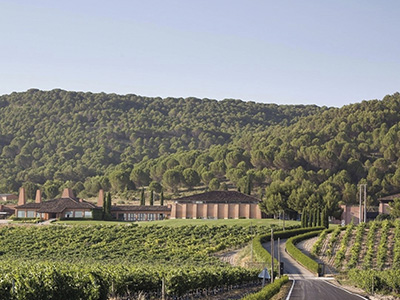Viña Mayor
N-122, km 325,6, 47350, Quintanilla de Onésimo, Valladolid, Spain
www.vina-mayor.es
Established in 1986 by Hijos de Antonio Barceló, Viña Mayor is a long-standing producer in Ribera del Duero and a familiar presence among the wineries lining the N-122 road between Sardón and Peñafiel in what has come to be known as Ribera's "golden mile".
As the rest of bodegas owned by Hijos de Antonio Barceló, Viña Mayor was eventually integrated into Acciona, a leading Spanish player in both infrastructures and renewable energies. In 2017, Acciona relaunched its winemaking division under the name Grupo Bodegas Palacio 1894 -it adopted the name and foundation date of its oldest winery (Rioja Alavesa), located in Laguardia (Rioja Alavesa). Finally, in 2021 the company was renamed Entrecanales Domecq as the eponymous family took full control of the grupo.
Other wineries include Finca Caserío de Dueñas in Rueda and Bodegas y Viñedos Anzil in Toro. Bodegas the group has recently started to produce wines in Valdeorras (Galicia).
At Viña Mayor, the goal from the very beginning was to produce red wines with ageing, value for money and good availability in national and international markets. The arrival in 2015 of winemaker Almudena Alberca, who became a Master of Wine three years later, meant a leap forward in terms of quality as she updated the traditional range and sought contemporary styles. She is also the group’s technical director.
Viña Mayor handles around 2m kg of grapes every harvest and produces the whole range of categories in the area: from Roble (€7 in Spain, the wine is aged for three months), through Crianza (€14, 12 months) and Reserva (€21, 15 months, 150,000-200,000) to Gran Reserva (€35, 24 months, 6,000 bottles). One of the main changes introduced by Almudena was that each wine would be made with specifically selected vineyards. Low tannin, fruity grapes with moderate colour are sought for the Roble, whereas the Crianza comes from 16- to 20-year-old vineyards from various areas producing grapes with good acidity and fruit. Introducing an optic sorting machine has considerably improved the selection for the Crianza.
The premium range includes three wines: Reserva, Gran Reserva and El Secreto. Grapes are sourced from 60- to 90-year-old vineyards from elevated areas in the provinces of Soria and Burgos. Some villages include Peñaranda, Quemada, Gumiel de Mercado, Gumiel de Izán, Quintina del Pidio and La Aguilera. Black fruit, tannic grapes are destined to Reserva and Gran Reserva (this one is made from a selection of Reserva plus pressed wines from old vines) and the more aromatic grapes with finer tannins are used for El Secreto (€17, 40 to 45,000 bottles).
El Secreto tries to capture the area’s most elegant version. Accordingly, ageing takes place in 300- and 500-litre oak barrels and a foudre. Two egg-shaped concrete vats are also used to age wines with “such round tannins that there is no need to tame them,” says Almudena Alberca.
Tempranillo is the dominant grape in all cases, although small amounts of Malbec and Cabernet Sauvignon are also used. “Malbec blends in nicely and provides aroma and freshness; it is a good addition although I prefer Cabernet to gain structure in the wines,” Almudena points out. Cabernet in fact accounts for 10% of the Reserva blend.
The Spanish Master of Wine favours early harvests to avoid overripe grapes, low pH levels and preserving the wines’ aromas. She believes that having long-term agreements with growers is essential, especially for a winery like Viña Mayor which only owns 10 hectares of vines surrounding the winery (including two hectares of goblet-trained Garnacha).
Viña Mayor currently exports between 25% and 30% of its wines. Wine tours are available at the winery. Visitors can choose from a variety of wine tasting experiences, special activities during harvest time or become a winemaker for a day.
Most popular
NEWSLETTER
Join our community of Spanish wine lovers


